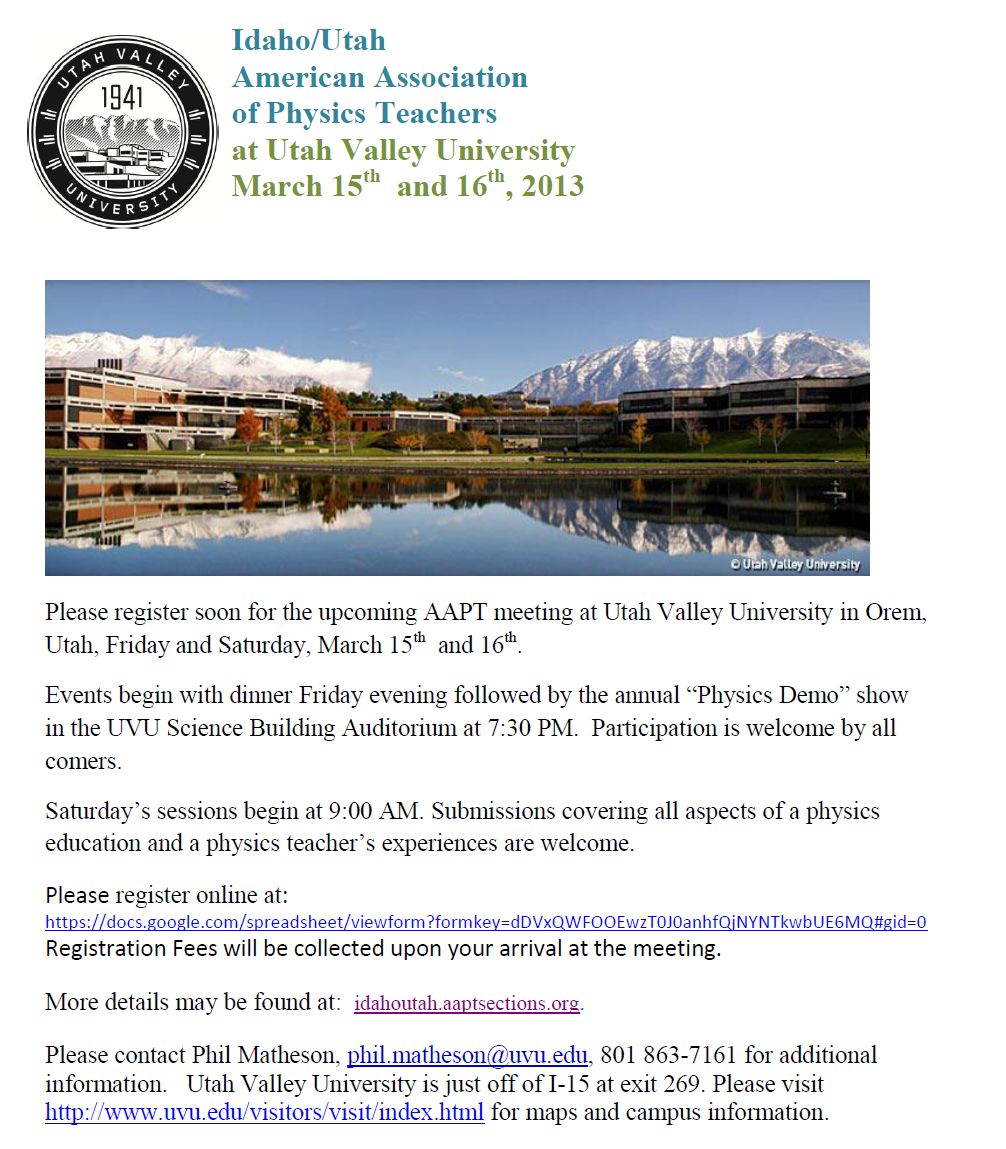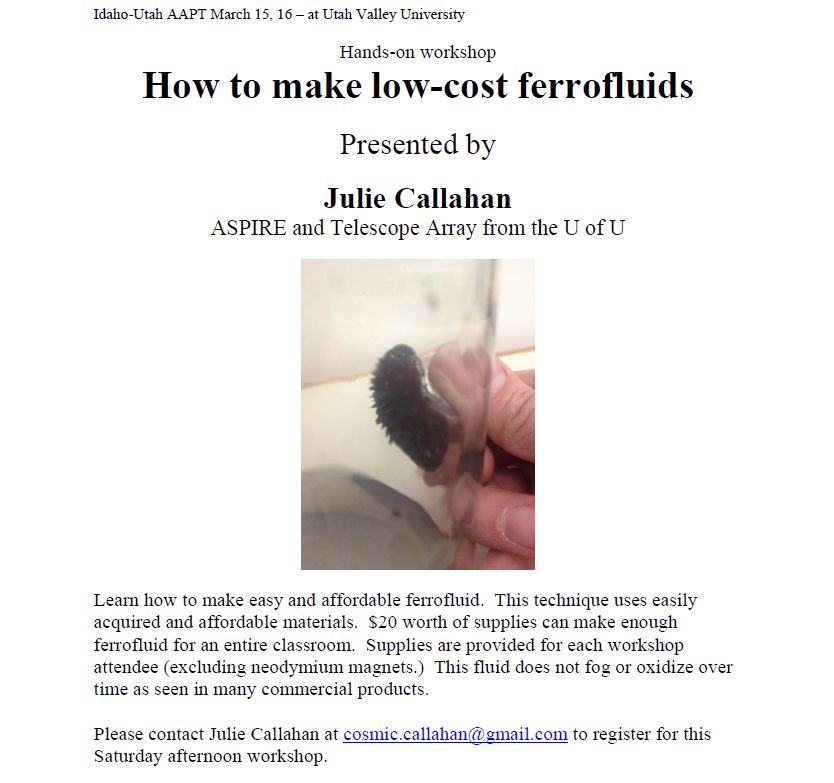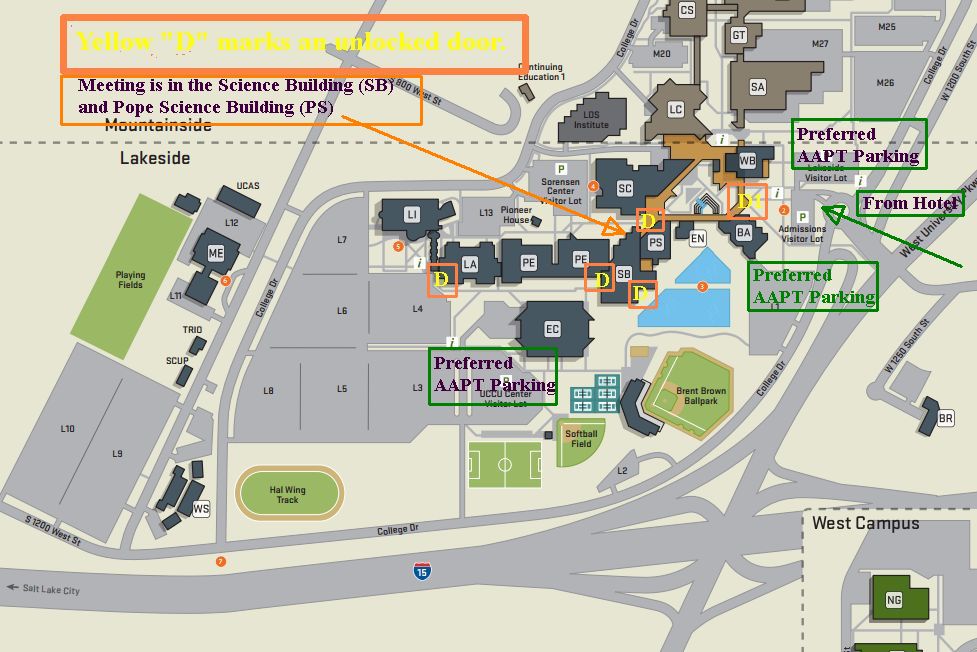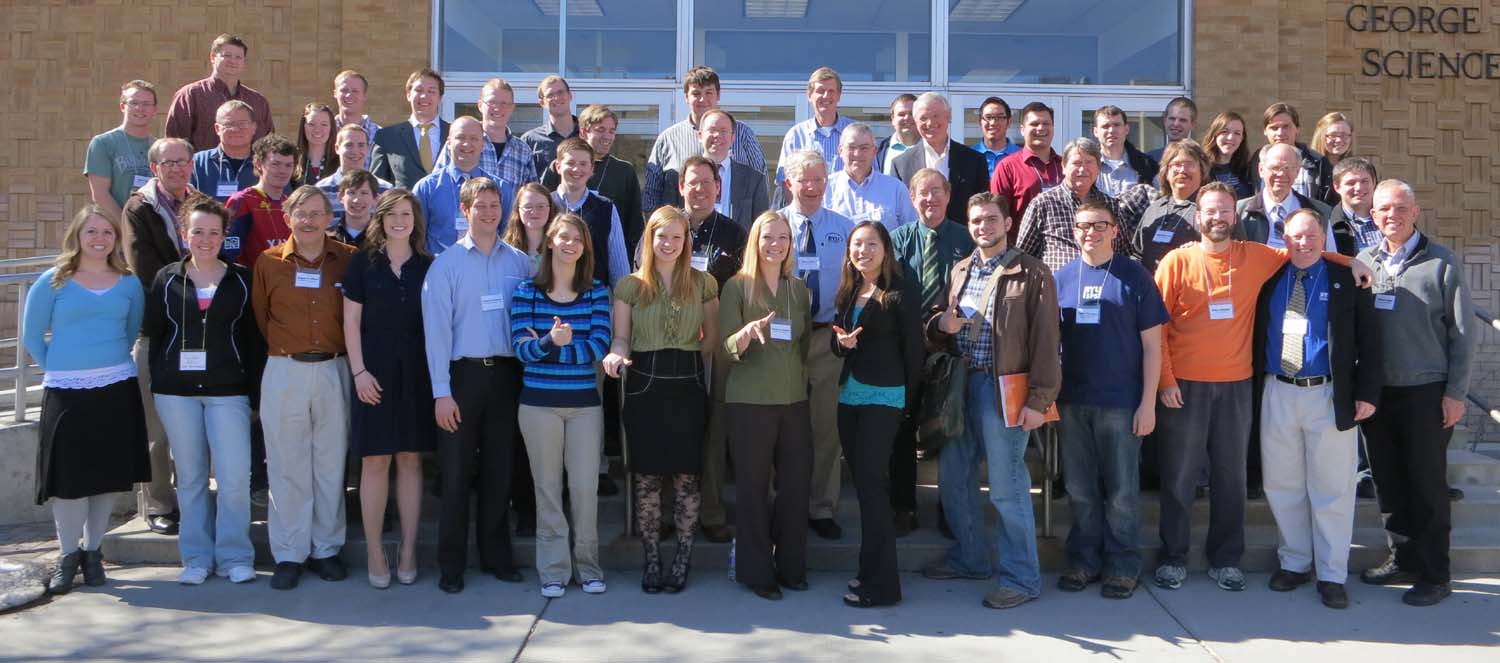ID-Utah AAPT Meeting, March 15 and 16, 2013 Utah Valley University.
Program Outline:
Friday, March 15th
4:00 – 6:00 PM Registration Science Building Atrium (by SB 134)
6:15 – 7:15 PM Dinner Golden Corral 225 W. University Parkway
(Meet as a group to be seated as a group – $10.99/meal)
7:30 – 9:00 PM Physics Demo Night Science Building SB 134
Participants:
Wayne Peterson, BYU Two Demos: The Siren Disk; Creating a Plasma in a Microwave Oven
Brian Pyper, BYU-I Miscellaneous Demos
James Coburn, USU Several demos and a new way to make them visible.
Adam Beehler, U of U Eyeglass Diagnostics
Richard Hills, WSU Galileo’s Regret, Newton’s Rocker, & Bossie’s Stutter-Step
Blake Centini, U of U Fun with magnetism and light
Paul Mills, UVU “Run of the Mills Demos”
Phil Matheson, UVU “Finger demos”
Saturday, March 16th
8:00 – 9:00 AM Registration Science Building Atrium (by SB 134)
(All talks are held in:)
9:00 – 9:10 AM Welcome Pope Science Building PS-202
Session Chair: Bonnie Andersen, UVU
9:15 – 9:30 AM Brent Bargeron, UVU Exit Interviews, a Useful Component of Departmental
Outcomes Assessments
9:30 – 9:45 AM Bill Evenson, UVU/BYU Improving Student Learning Through “Tuning”
9:45 – 10:00 AM Sarah Young, BYU-I Higher Test Scores Achieved by Students who Learn
Physics for the “Big-Picture”
10:00 – 10:15 AM Hector Davila, Joe Jensen, UVU Learning in Bigger Classes
10:15 – 10:30 AM Snack Break, Science Building Atrium
10:30 – 10:45 AM Tracianne Neilsen, Kent Gee, BYU The Physics of the Voice
10:45 – 11:00 AM Kent Gee, Tracianne Neilsen, BYU Teaching Sound Propagation at BYU
Football Games
11:00 – 11:15 AM Paul Weber, UVU Enhancing Modern Physics by Including Waves
11:15 – 11:30 AM Steve Wasserbaech, UVU In Class Demo: Solving the Schroedinger
Equation with an Excel Spreadsheet
11:30 – 11:45 AM David Ludlow, BYU Eliminating Algebra Mistakes in Physics Homework
With the Math Drag’n Application
11:45 – noon Dallin Durfee Exploring the Physics of Musical Scales with a MIDI
Noon – 1:30 PM Lunch/AAPT Business Meeting/ SPS Poster Session/Raffle Prizes
(Pick up your lunches in the Science Building Atrium, and eat in PS 202)
(SPS posters are in the Science Building Atrium)
(AAPT business meeting and raffle at 12:45 in PS 202)
(GROUP PHOTO AT 1:15 SHARP – In the Science Building Atrium)
AAPT continuing:
1:30 – 1:45 PM Rondo Jeffery, Fahrang Amiri , WSU Jumping Ring Levitation and other
Recent results
1:45 – 2:00 PM Bonnie Andersen, UVU Teaching LabVIEW with the Vernier SensorDAQ
2:00 – 2:15 PM Bonnie Andersen, UVU Applying Principles of Team Based Learning
In Lower and Upper Division Physics Courses
2:15 – 2:30 PM Dan Schroeder, Weber AJP and the Future of Physics Journals
2:30 – 2:45 PM Phil Matheson, UVU What should be taught in an “Energy Course”?
2:45 – 3:00 PM Cameron Summers, BYU-I Physics Attitudes Influence Learning
SPS Breakout meeting:
1:30 – 2:15 PM SPS leadership Pope Science Building 206
(Planetarium)
Optional Event: Hands on Workshop
1:30 – 3:00 PM Julie Callahan Cheap Ferro-fluids
Location to be announced
Optional Event: Planetarium Show
2:15 – 3:00 PM UVU- Planetarium Pope Science Building 206
List of SPS Posters
Monica Cervantes, UVU Real-time pathology with high-frequency ultrasound. A feasility study
using bovine tissues
Joseph Chandler, Merideth Gold, BYU BYU SPS Outreach Team
Margaret Jensen, USU Annual Solar Motion and Spy Satellites
Darren McKinnon, USU Mapping the Milky Way: Seeing the Galaxy at 1420 MHz
Rachel Nydegger, USU Effects of Light Pollution at Utah State University
Kelby Peterson, USU Simulation of UV Induced Discoloration on Space Polymers
Jordan Rozum, USU Modeling Spiral Galaxy Surface Luminosity to Explain – Non Uniform
Inclination Distributions
Laurel Thompson, UVU Methods for identifying aerosols by light scattering techniques
David Pease, UVU Testing Regions of Frequency Hysteresis of a Variable-Depth
Thermoacoustic Prime Mover







